The Great Buddha of Nara, or Nara Daibutsu
at Todai-ji temple.
I
am not big on shopping. Even though I am in Japan, it is hard to think that wandering in and out of shops, looking at the same things is a good use of my time… and frugal budget. I just have the clothes on my back and a backpack with only another change of clothing used for my pilgrimage. Yep, that’s all I have.
As a matter of fact, if you must know, I am still wearing that clothing (occasionally laundered) to visit cities and temples beyond Koyasan. I am definitely traveling light!
What can an ohenro who is shaking off the dust of a 1200 kilometer walk… do? Walk and ride some more.
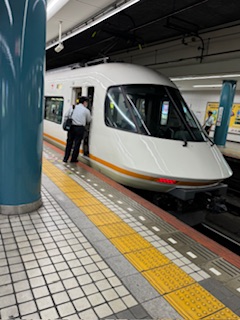
Let’s see, my destination pick for today is Nara, about a 40 minute train ride from Osaka. It is an easy journey on the JR rapid train.
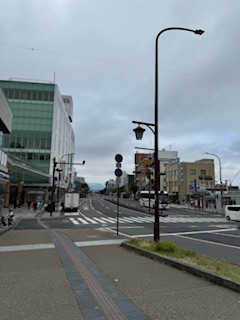
Then I walked through Nara Deer Park to the temple grounds.
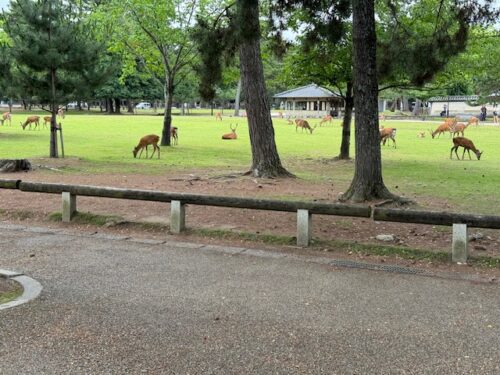
Nara
Nara was once the capital of ancient Japan and the center of culture and civilization. In Heijo Palace, visitors can see evidence of Nara’s ancient city plan, and the grandeur of the old capital.
Nara’s status as a national cultural monument is reflected in a Japanese proverb: “See Nara and die”; that is, one can die content if one has seen Nara.
The Nara Period (710-794) was an important era for Japanese culture, establishing the foundation of the national government. During this period, the Emperor Shomu united the nation through Buddhism, and decreed the establishment of Buddhist temples in each province across the country. Chief among these was Todai-ji Temple.
Todai-ji
Eastern Great Temple
Todai-ji can only be seen to be believed.
Great South Gate
What you see when you approach the temple is the rustic Nandai-mon or Great South Gate. It is the largest temple gate in Japan. Two benevolent Niō kings welcome visitors to this magnificent sight. And that is not the least to appreciate about the temple complex at Nara.
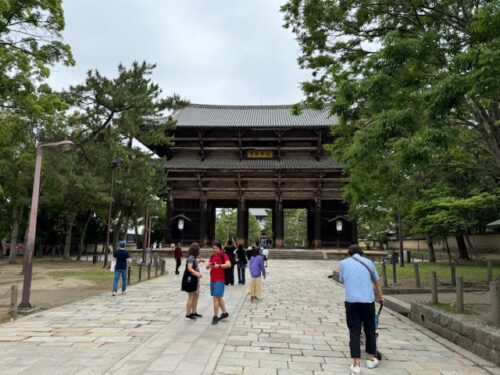
Nandai-mon Gate
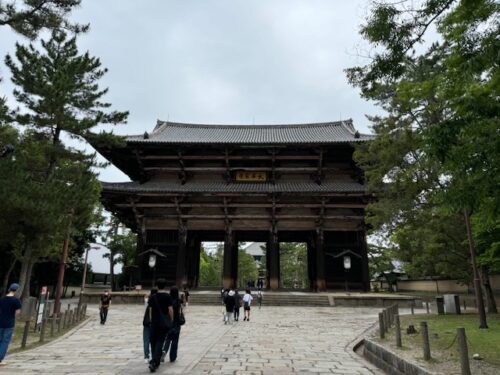
Twenty-eight foot tall Niō guardians, kongōrikishi, keep watch at the Gate. They were carved in 1203 by the master sculptors Kaikei and Unkei.
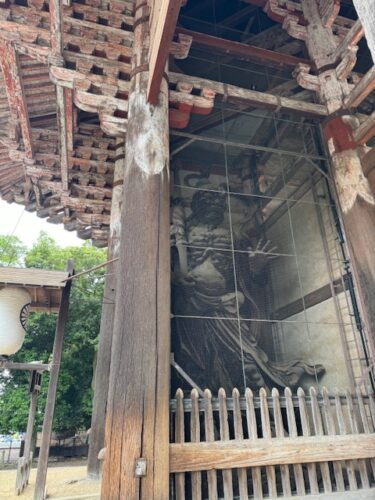
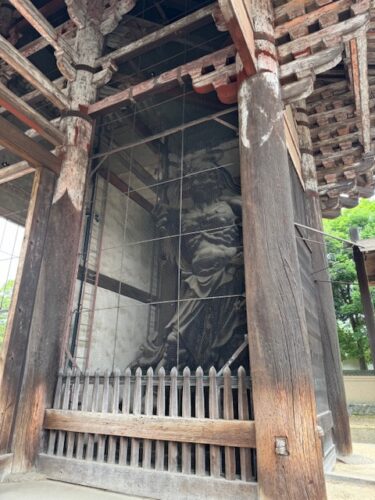
Angyo (left) and Ungyo (right).
From the start, Todai-ji had the function of concentrating and administering six different Buddhist sects of Japan from the Nara period, the Nanto Rokushu or the Six sects of Nara.
As the head of all the temples, Emperor Shomu was the authority and official monks had to be ordained there. Kukai was ordained here.
Todai-ji’s reputation spread thanks to Kukai. At the initiative of the Shingon sect, he took charge of both the religious affairs of the empire and the administration of Todai-ji. Today, the temple remains the source and most active place of worship and training of the Kegon sect.
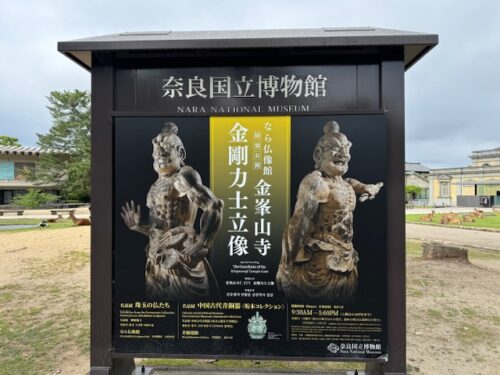
Nara National Museum exhibit information on the temple road.
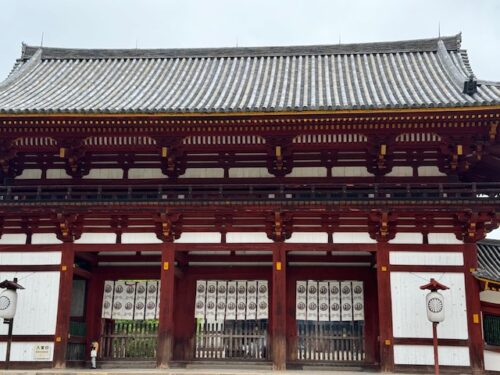
Chumon, the red Middle gate is between the Great South Gate and Great Buddha hall.
Putting it together
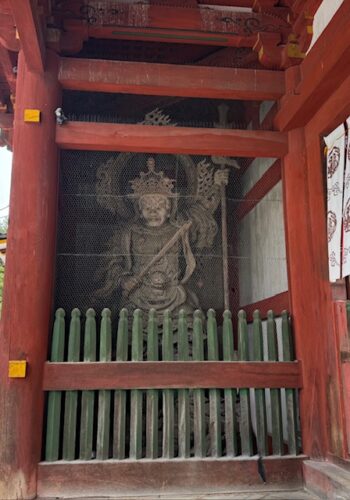
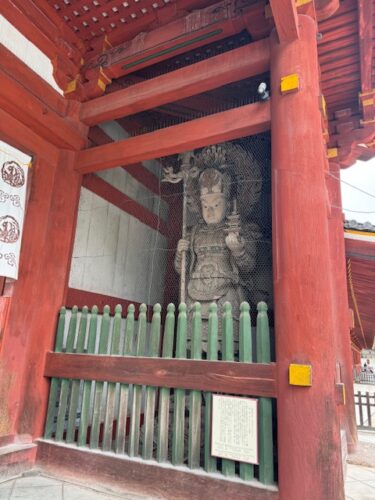
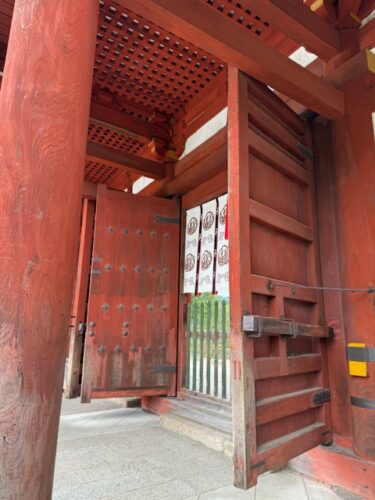
I like figuring out how things work. That includes Japanese woodworking joinery, architectural, carpentry, and woodworking details. Some methods were developed and passed on for centuries. Disasters, while tragic, present opportunities to reinforce knowledge, skills, methods and train current generation tradeswomen and tradesmen in these ancient arts.
As a result, temple buildings, stonework, metal and tile work are faithfully reproduced or rebuilt.
Daibutsu-den
Great Buddha hall of Todai-ji. The original structure was a larger rectangular building. After fires over the centuries, it was rebuilt at least two times, but the final reconstruction afforded a square shape, about 30 percent smaller. Still it is the largest wooden structure in the world.
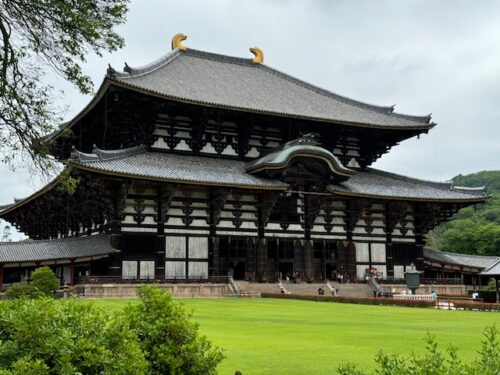
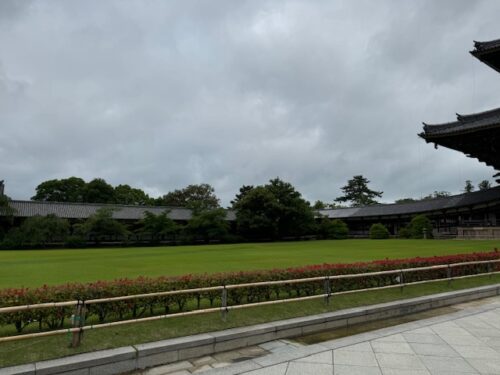
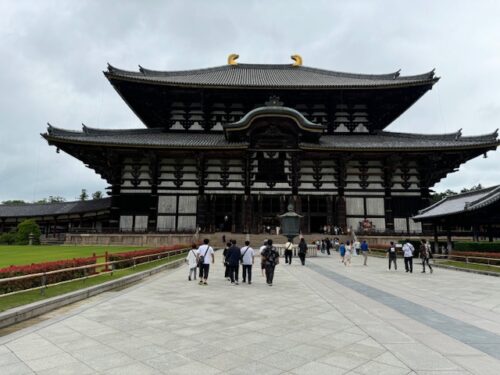
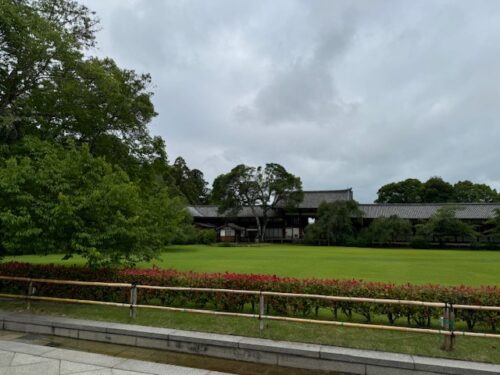
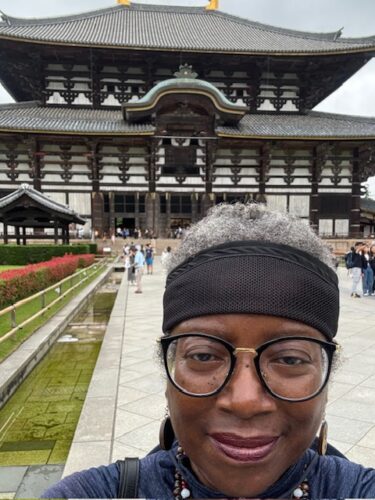
The temple precinct has many buildings where a goshuin can be obtained for stamp books. I got my goshuin, here, at the Great Buddha hall.
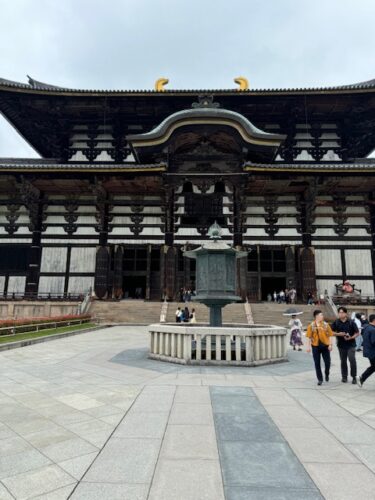
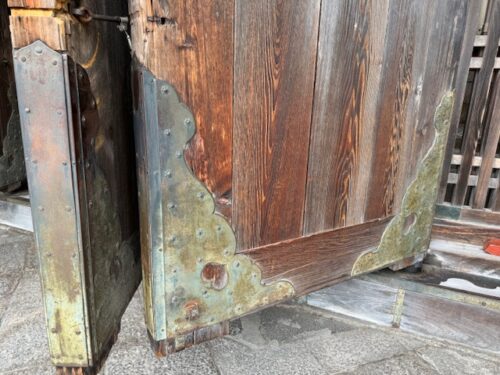
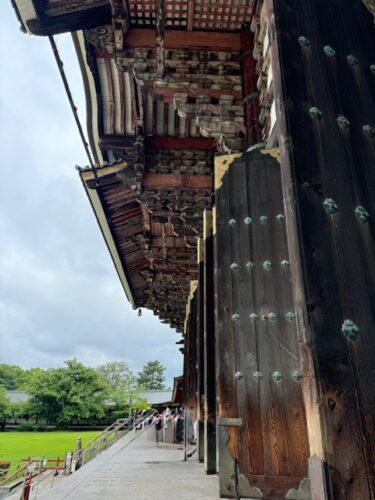
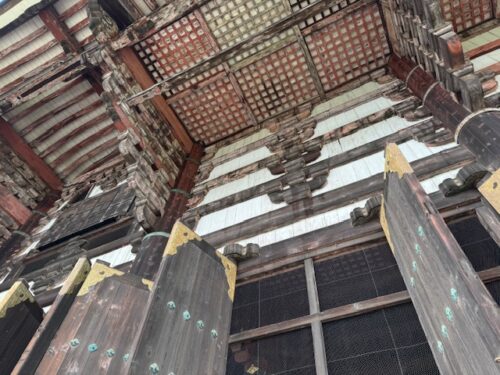
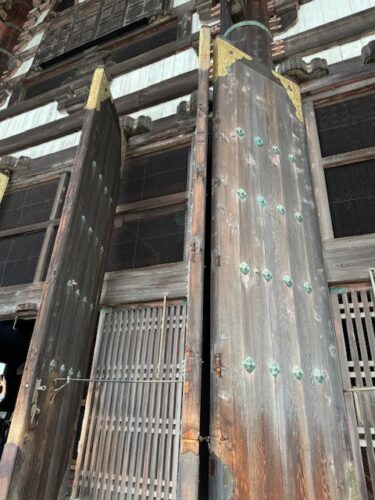
More architectural details and woodworking. I picked up a few tips!
The healing Arhat
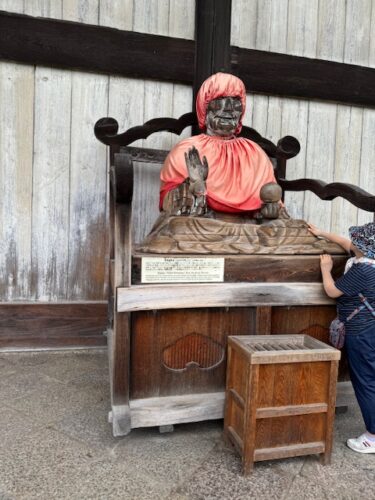
Outside the hall, a wooden statue of Binzuru Pindola Bharadvaja is seated in the lotus position. He is one of 16 Arhats designated by the Buddha Sakyamuni at his death to keep spreading his teachings.
It is believed that if you touch a part of the Pindola in the same part of your body where you are ailing, it will be immediately cured.
If you have back problems, the statue will not work for you, directly, because its back is out of reach! Life is a beach, surely.
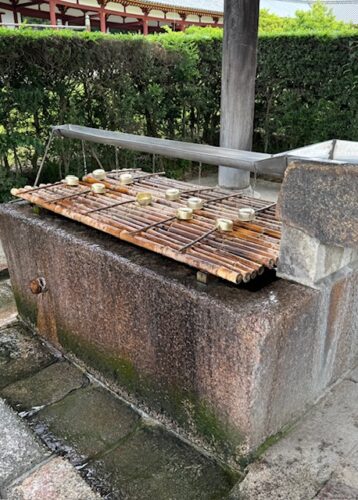
Nara Daibutsu
The Great Buddha of Nara
The large bronze Buddha, Nara Daibatsu, represents the growth of Japan.
The Buddha is 16 meters (53 feet) tall.
It was originally crafted and cast from tons of molten bronze, mercury, and vegetable wax. And it was gold-plated. The Buddha’s making nearly bankrupted the country!
Also, massive cypress wood posts, sourced from all over Japan, are used inside the building.
The curled hair, completed two years after the Buddha, is a symbol of his divinity.
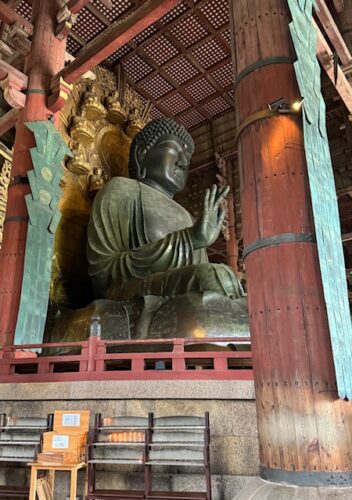
The Daibutsu is properly known as Vairocana Buddha,
the Buddha the light of whose knowledge and compassion illumines widely.
The Buddha’s guardians are large sculptures, made of wood, who stand nearby inside the Daibutsu-den.
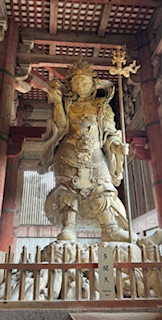
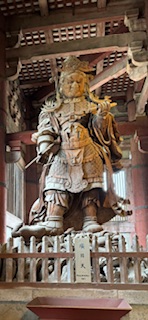
Having guardians could not prevent the head of the Great Buddha falling off in a major earthquake in 855. The image was restored with a sturdy one that survived attacks on Nara temples in 1180.
Two gold-covered wooden Bodhisattvas sit beside the Buddha.
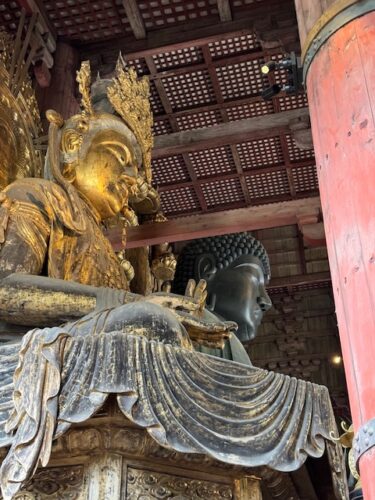
A golden Kannon, Kokuzo Batsatsu, sits next to the Buddha.
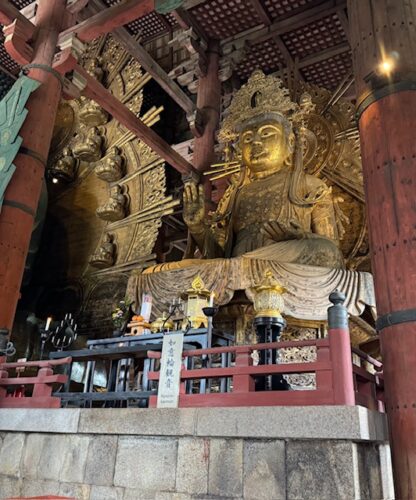
Another Kannon sits on the other side.
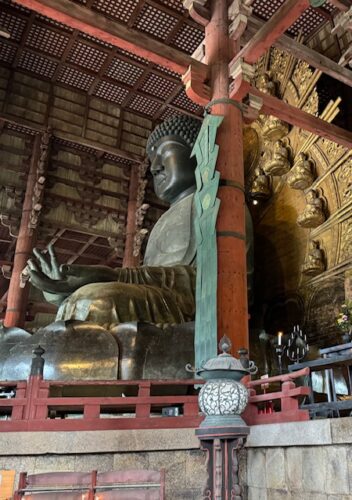
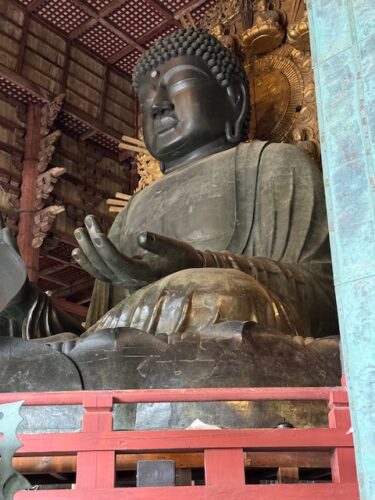
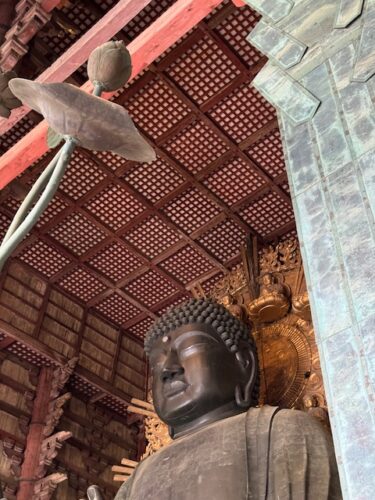
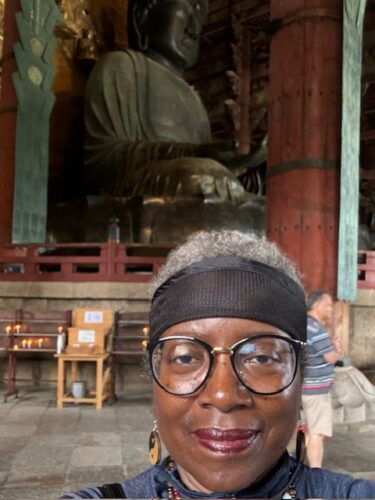
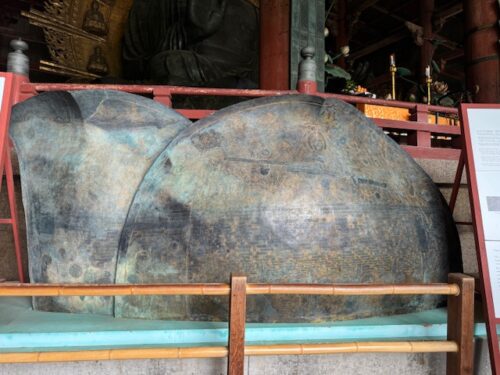
Inscribed lotus leaves from the original Great Buddha statue.
If you noticed the gold horns on the roof of the hall, here is one up close!
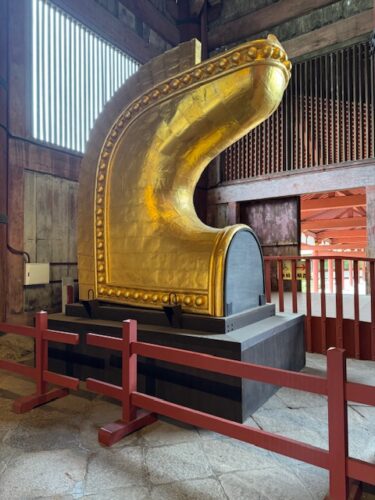
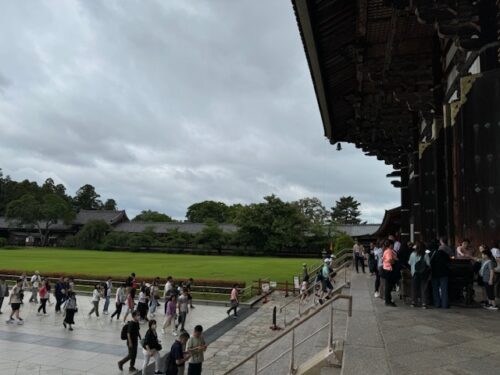
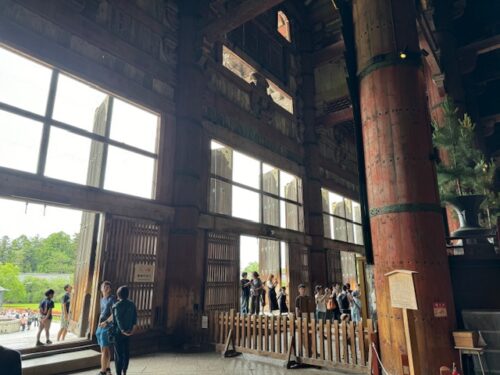
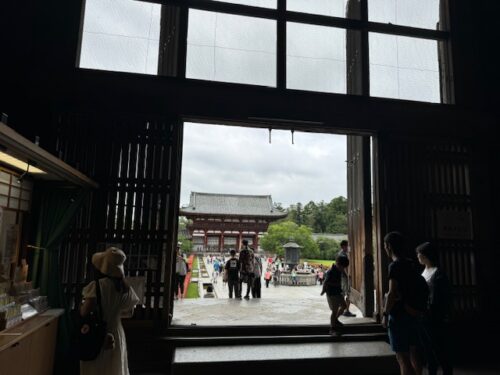
View out the door of the Great Buddha hall featuring the red middle gate and the original brass lantern.
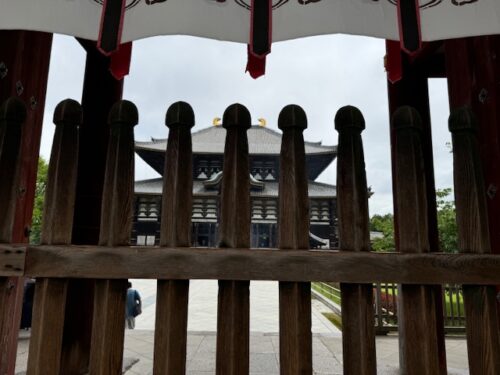
Nature is all around.
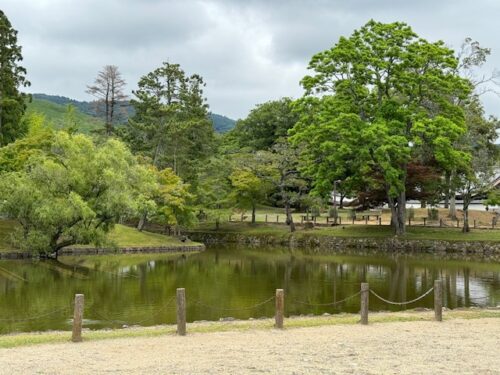
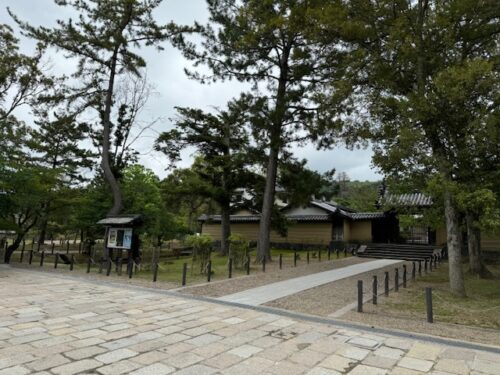
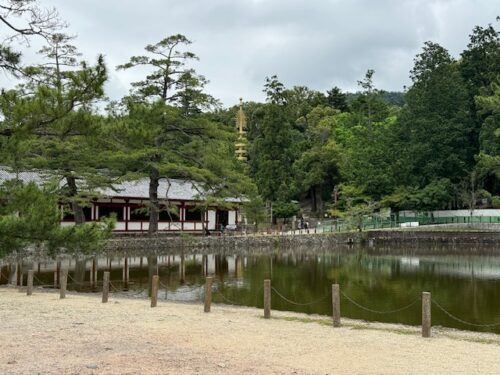
Pond on the temple grounds.
Bell Tower
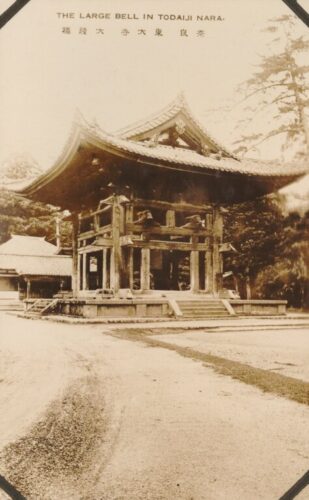
Postcard featuring bell tower in 1930.
(source: wikimedia commons)
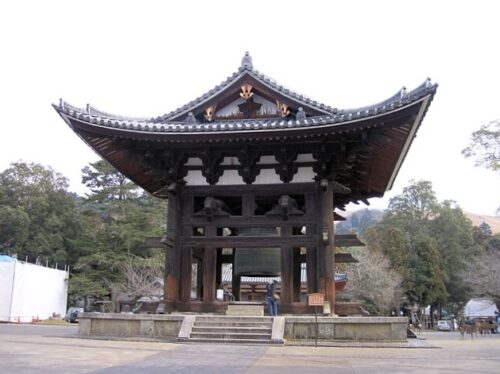
My intention in Nara was to see the Great Buddha. Other temples and shrines are close by Todai-ji in Nara. It requires more than one day to see it all. I visited or walked by a few. Perhaps I will see the rest on a return trip to Japan.
Kofuku-ji temple
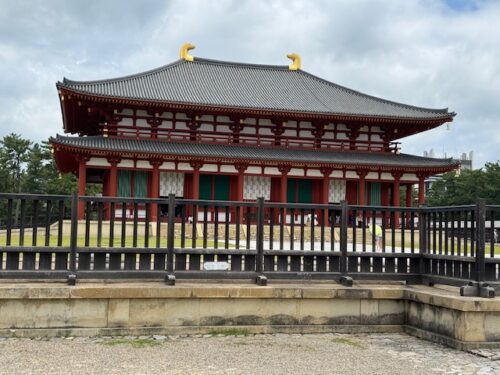
Central Golden Hall.
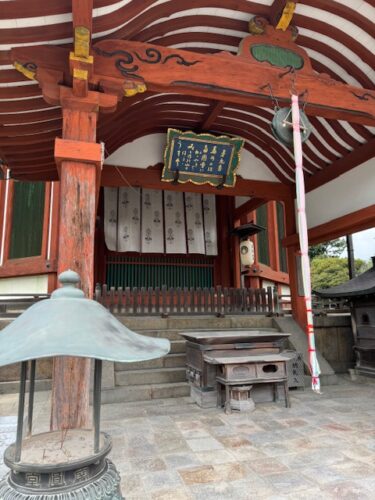
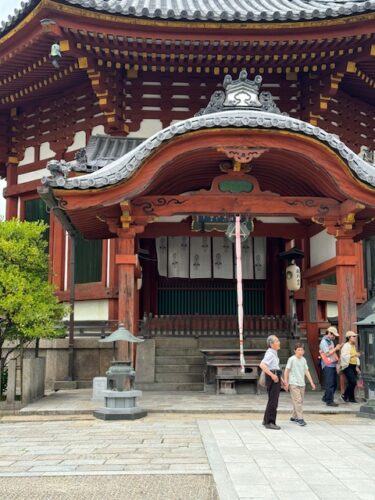
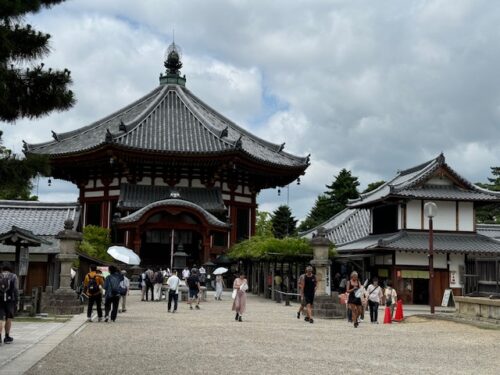
Southern Round Hall.
The five-storied pagoda was under re-construction.
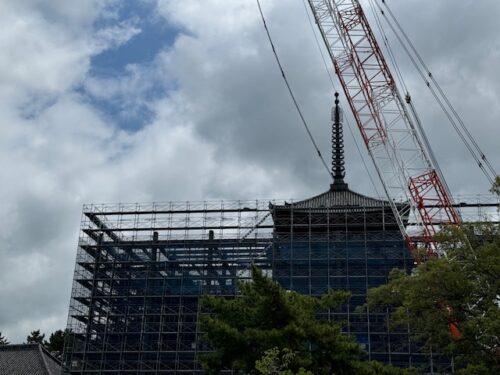
I was told that the structure has a tendency to catch fire! Not a surprise at all.
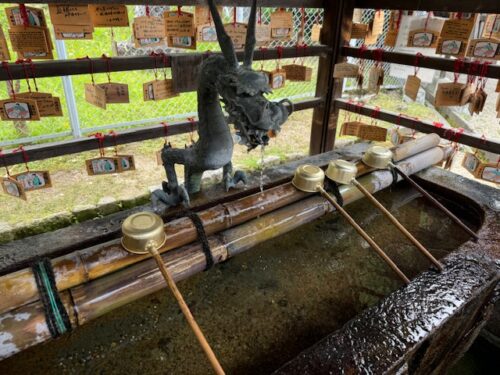
Kasuga-Taisha Shrine
Shrine of a Thousand Lanterns
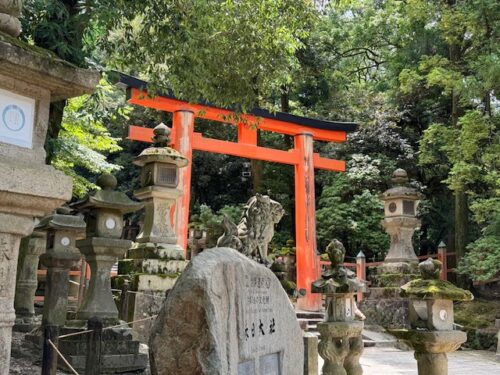
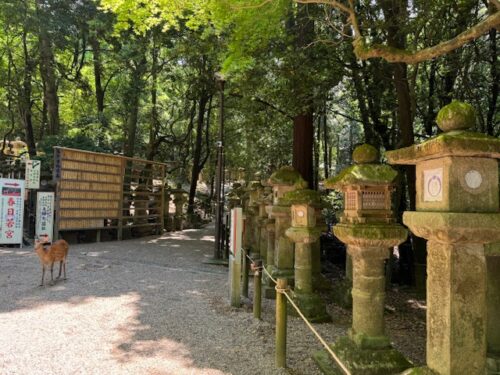
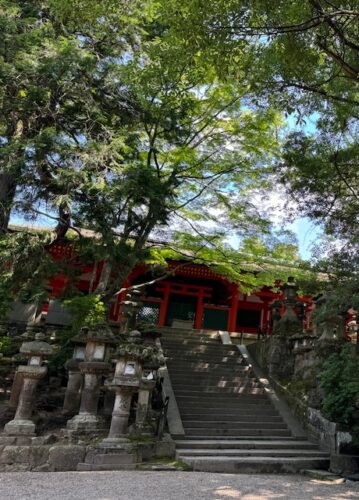
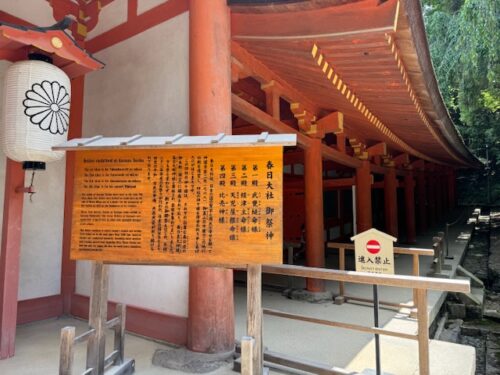
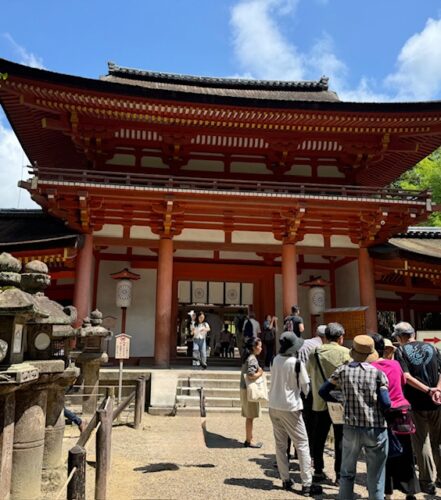
Himuro Jinja Shrine
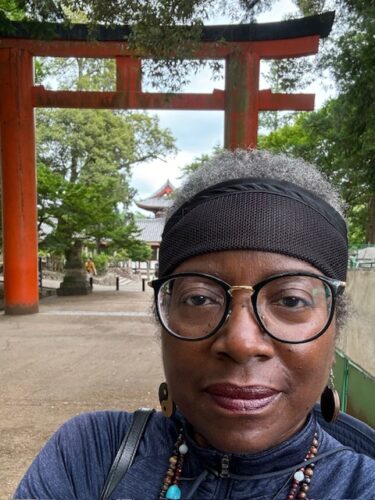
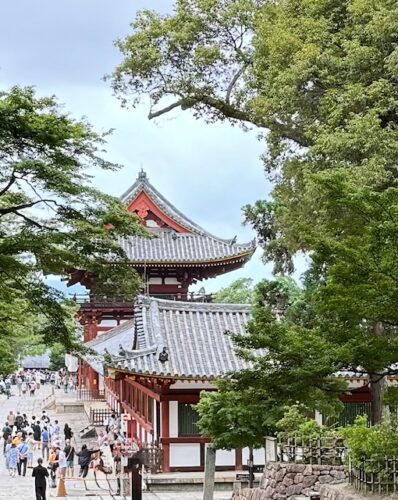
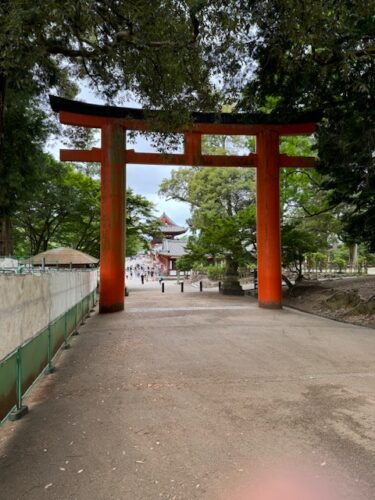
Ancient temple precinct Imagined
In the past, Todaij-i’s Daibutsu-den Hall was flanked by two seven-storied pagodas, which were each about 100 meters tall. In 2015, the exact location of the former east pagoda was ascertained.
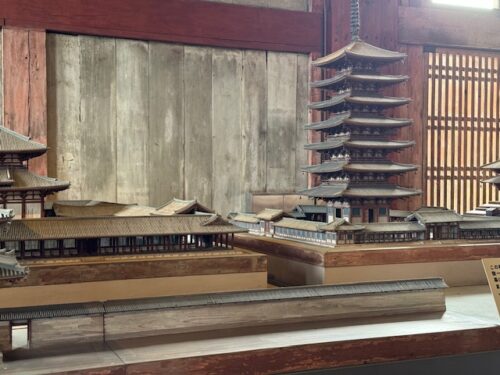
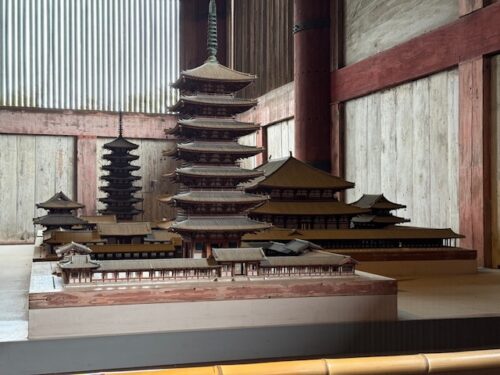
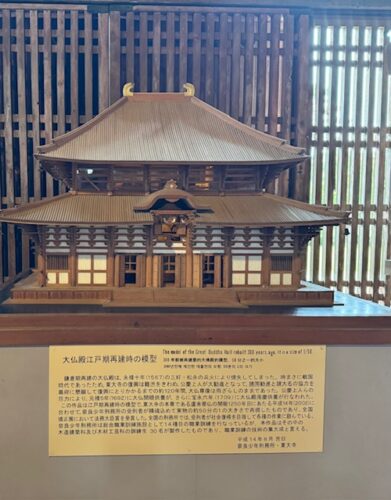
The Todai-ji Great Hall was rebuilt in 1709. Three hundred years later, it was rendered in a 1/50 scale model built by inmates at Nara Juvenile Prison “with their heart and soul”. It was in efforts to rehabilitate themselves and return to society.
One interesting fact about the temples at Nara, and much of Japan is the rarity of a temple and structures that survived from its original inception. Many were objects of fire, attacks during regional wars, bombings, tsunamis, earthquakes, lightening strikes, confiscation, and intentional destruction in the name of religion!
Almost all of them have been reconstructed, rebuilt, reconfigured, or removed to other locations and rededicated through the efforts of believers and others who value them within their religious meaning.
Most every structure in the Todai-ji complex is at least a designated national treasure due to the history of the area and Nara’s past history as the capital of Japan. The temple and nearby temples are UNESCO World Heritage Sites.
There are numerous other temples, buildings, statues, sculptures, treasures, and precincts that I did not visit on this trip. I only whet my appetite here today. Perhaps, I will return one day. 🕉️
Here my deer
At one time, deer were considered divine beings. Their ranking has been reduced, slightly. However, they are still protected on the grounds. Visitors are even permitted to feed them with special deer crackers purchased from vendors.
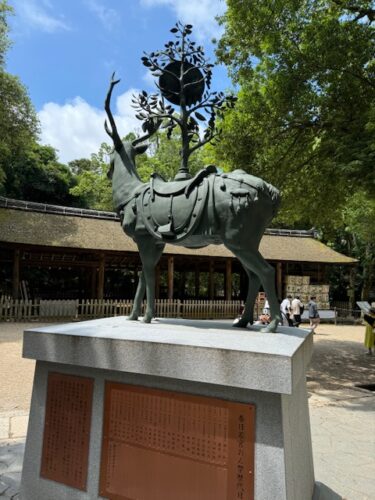
Of course, the wily creatures know how to get a handout. They will do a bowing gesture that indicates they want food. Before you know it, you have been trained to respond to their whim. Otherwise you may get ignored at best or a little nip on the “bud” at worst! Of course, their wants and tastes are not limited to those corporate crackers. If you have any food on you, they will knock you down to get it.
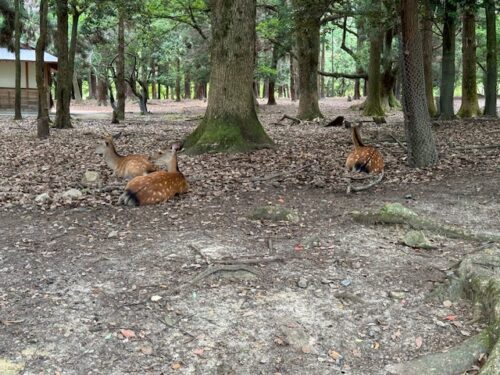
Be careful!
Just Looking
On the walk back to the train station, I spotted a shop outside Nara Park that specialized in the traditional two-toed boots or jika-tabi that some pilgrims favor on the pilgrimage. The boots in the shop are a modern take of the style. There are interesting variations in colors and materials. Socks, made in the same style, are whimsical, too. I noticed that the shoe sizes run a little small for me. Nonetheless, they were very expensive!
The walk to the JR station at Nara did not take long.
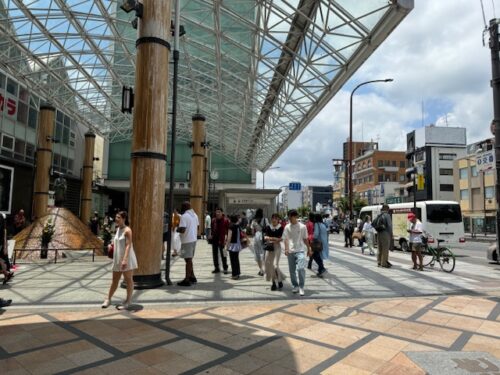
Time to get back to Osaka.
See you next time.
Baadaye and Mata Ne (またね)
Shirley J ♥️
This and several posts this summer chronicled my pilgrimage in Japan where I walked the 1200 kilometer-long Shikoku 88 temple pilgrimage and beyond. Read my announcement here.

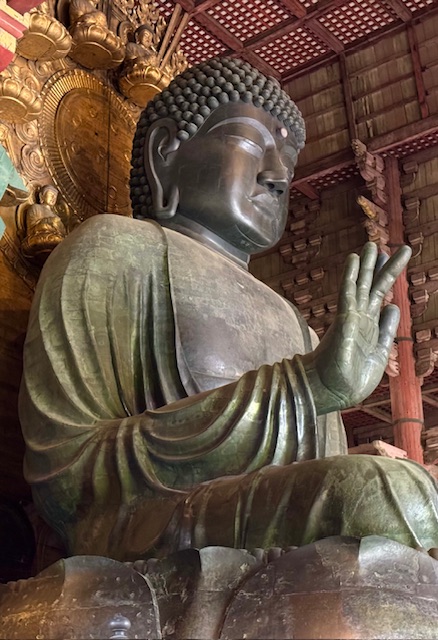
4 thoughts on “🌸 Noire Henro-san: Nara”
Definitely the trip of a lifetime! Thanks again for bringing us along!
Acting like a local! 🇯🇵
Another great stop with too much to take in all at once. Are you nearing the end of the trip?
Thanks for reading. It was a lot to take in. I see why people return for visits here. My pilgrimage officially ended at Koyasan. I finished a little earlier than planned, so I am visiting some places here that are part of the story of Buddhism and on my bucket list. That is what I am posting now. Then, I will be on a plane headed home and back in my wood shop. Again, thanks so much for following me on this walk of a lifetime.🕉️🌸
Comments are closed.